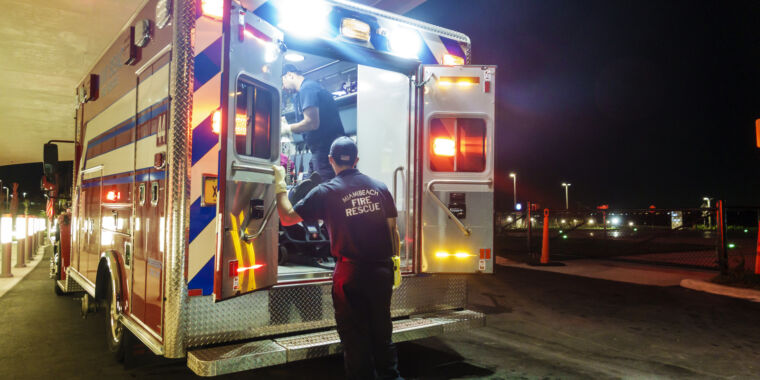Hospital prices for the same emergency care vary up to 16X, study finds
Activation fees —
Hospitals’ “trauma activation fees” are unregulated and extremely variable.
![Miami Beach, Fire Rescue ambulance at Mt. Sinai Medical Center hospital. ]](https://cdn.arstechnica.net/wp-content/uploads/2024/04/GettyImages-1189385839-800x533.jpeg)
Enlarge / Miami Beach, Fire Rescue ambulance at Mt. Sinai Medical Center hospital. ]
Since 2021, federal law has required hospitals to publicly post their prices, allowing Americans to easily anticipate costs and shop around for affordable care—as they would for any other marketed service or product. But hospitals have mostly failed miserably at complying with the law.
A 2023 KFF analysis on compliance found that the pricing information hospitals provided is “messy, inconsistent, and confusing, making it challenging, if not impossible, for patients or researchers to use them for their intended purpose.” A February 2024 report from the nonprofit organization Patient Rights Advocate found that only 35 percent of 2,000 US hospitals surveyed were in full compliance with the 2021 rule.
But even if hospitals dramatically improved their price transparency, it likely wouldn’t help when patients need emergency trauma care. After an unexpected, major injury, people are sent to the closest hospital and aren’t likely to be shopping around for the best price from the back of an ambulance. If they did, though, they might also need to be treated for shock.
According to a study published Wednesday in JAMA Surgery, hospitals around the country charge wildly different prices for trauma care. Prices for the same care can be up to 16-fold different between hospitals, and cash prices are sometimes significantly cheaper than the negotiated prices that insurance companies pay.
“The findings illustrate substantial, and often irrational, variations” in trauma pricing, according to the study authors—a group of researchers at Johns Hopkins and the University of California, San Francisco. They suggest that “price variations cannot be explained by trauma severity alone.”
For the study, they obtained data on “trauma activation fees” (TAFs) from hospitals across the US. TAFS were created in 2002 to be standardized billing codes that would help recuperate readiness costs for trauma care. Those overhead costs are what hospitals pay to maintain readiness to provide emergency trauma care around the clock, including having operating rooms constantly ready, as well as sufficient staffing, equipment, and supplies, like blood products. TAFS are billed with four codes corresponding to trauma response levels (I through IV), which are based on standardized criterion of injury severity. These fees are in addition to billing for a patient’s actual medical care.
Wide variation
The researchers pulled TAF data from a platform that aggregates hospital-disclosed pricing data called Torquise Health. From there, they obtained 3,093 unique TAF observations across 761 unique hospitals in 49 states. They broke out TAF fees by different types of trauma response levels as well as types of prices: list prices, cash prices often paid by the uninsured, and negotiated prices paid to insurers.
The prices varied dramatically for each trauma level and pricing type. For instance, for the most severe trauma response level (level I), the median TAF list price was $6,607, while the median negotiated price was $3,431, and the median cash price was $2,663. For the list prices, the span between the 10th percentile prices and the 90th percentile prices went from a low of $1,650 up to 11 times more than that: $18,500. Looking across the percentiles for the negotiated prices, costs ranged from $900 to 11,661, 13 times more. And the cash prices ranged from $660 to $8,190, 12 times more.
The largest spread was seen in the cash prices for trauma response level II TAFs. There, the median cash price was $2,630, but the span between the 10th and 90th percentiles was $768 to $12,140, which is 16 times more.
In all the data, cash prices were often lower than the negotiated prices. This is good for uninsured patients who may be offered cash prices, but it’s not great for the insured. “One could argue that insured patients who are already paying insurance premiums should not pay more than cash prices,” the authors wrote.
Overall, the pricing and lack of transparency is a problem that requires intervention, the authors conclude. “The unexpected and pressing nature of trauma means patients are sent to the closest appropriate hospital and unable to compare prices as they do with nonemergency and shoppable medical services,” the authors wrote. Moreover, the people who will suffer the most from these wide-swinging prices are the uninsured and most financially vulnerable patients, they add.
Hospital prices for the same emergency care vary up to 16X, study finds Read More »
